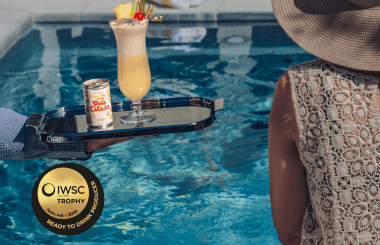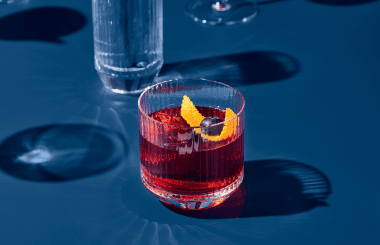2023 Alternative Drinks Judging - deliberations from our judges - days 1 & 2
Following two days of judging for the IWSC's Alternative Drinks Awards, our 40+ judges were treated to many delights from our multi-category awards, including Low/No alcohol drinks, RTDs, Vermouth, Mixers and many more categories. We caught up with our Judging Committee members, who oversee all judging panels, Claire Warner and Shannon Tebay to hear the highlights live from the judging rooms. Full results will be announced on Monday 3 July.
Low/No
Looking firstly at the Low/No alcohol drinks category, as a very young category, it is great to see the marked increase in quality year-on-year, with brands really listening to our judges’ comments and the consumers’ drinks habits, our judges were pleased to see the narrowing of the gap between low/no alternatives and full-strength alcohol drinks.
New world drinks
The new world drinks category is an exciting one for the IWSC, it is home to many innovative and incredibly different drinks, with no specific alcoholic equivalent in the market. This year, the array of ingredients included in this category was a pleasant surprise for our judges, with a panel exclaiming that the drinks were “exceptional! With great skills demonstrated in recreating amazing flavours at a lower ABV”. This year we saw more entries for aperitivo, vermouth and spritz-style drinks, showing the low/no sector is offering the consumer so much more for the transition from day to night drinking. Our judges commented that these drinks “would work well as sippers but also fantastic in cocktails too”.
Agave low/no spirits
The large representation this year from low and no agave spirits was great to see, with our judges praising the tequila and mezcal alternatives that were judged. Again, showing how low/no brands are listening to consumer drinking habits in the full-strength alcohol drinks.
CBD/Wellness drinks
The judges were highly impressed by the flavours demonstrated in this category. With many entries standing out for their robust character and complexity. The judges commented on how they were discovering new and interesting drinks within this category, showing how it has evolved in the last year.
Liqueurs
The low/no liqueur alternatives blew our judges away this year, with 4 golds awarded to outstanding liqueurs, our judges praised the “unique and well-executed examples judged”.
Mixers
Our judges were impressed by the interesting ingredients that were used in the mixers entered this year. Of course, we had the classic citrus and also ginger flavours present, with our judges commenting, “a flight of ginger-based mixers all had their own merits and no two were the same showing some excellent work here”. But this year, the IWSC saw even more entries incorporating unusual ingredients showing that this category is constantly evolving. It’s great to see that the mixers are complementing the progressiveness of the new-world spirits on the market – showing real synergy within the low/no sphere, with the categories evolving side-by-side.
Lighter alcohol
Historically we have found that lighter alcohol has been slightly lagging behind no-alcohol drinks, but not this year, with entries growing, it is clear that consumers are now more confident with their understanding of ABV strength. It is also great to see that producers are finding a great balance between lightness and complexity, which can often come with smaller amounts of alcohol. Our Judging Committee member, Claire Warner commented “I think this is an area to watch, with a lot more innovative drinks coming to the market”.
Our judges awarded medals to a number of lighter alcohol wines, including silver medals to stand-out Sauvignon Blancs and a gold for an outstanding Pinot Noir, that displayed “pleasant stewed fruits on the palate, with integrated spice notes.” Our judges commented that the wines would work well with food. The medal-winning wines showed great varietal characteristics.
Dealcoholised wine
Our judges were greatly impressed by the leap in quantity and even more so in quality this year for the dealcoholised wine category. The medal results showed how the wine industry is really getting behind the low and no movement. Sparkling wines were a triumph with a number of medals awarded, namely two golds for stand-out sparklers. Over the years the IWSC has seen white, rosé and sparkling dealcoholised wine perform well, this year our judges were pleasantly surprised by the red wines entered. Shiraz was a grape variety that stood out to our judges, with them praising “the strength in colour, aroma and flavour”.
Non-alcoholic beers
Beer has been the leading drink in the low and no space for many years, there is great innovation in technology that has been applied to this category and that was evident to our judges. Our judges saw real diversity within the low and no beer category, with producers meeting the demand of a more discerning consumer.
Claire noted, “it is the first time that I really think entries could successfully compete with beers that contain alcohol, the strong complexity and delicious flavours of beers judged today was impressive. There really was no compromise, I think it would be tough for consumers to tell the difference between the beers tasted today and full-strength alcohol.”
RTDs
The Ready-To-Drink category has been showing consistent growth year-on-year, with the quality constantly improving and the producers experimenting with styles and ingredients. This year has been no exception, as our judges’ palates have been challenged with an incredible variety of flavours.
“The RTDs were varied and showed what innovation is going on in the market and how there is something for everyone, from the super accessible lychee martini to the ultra-fresh watermelon and mint hard seltzer to a sophisticated dirty martini or a first-class negroni. It's an exciting and growing category and it's a pleasure to witness its evolution,” our judges said following 2 days of tastings.
A few innovative takes on RTDs also impressed the judges, some of the gold-winning examples being a watermelon/mint seltzer and a raspberry lemonade. The latter, according to the judges ‘blew everyone’s mind’ with its expressive nose and a well-rounded palate, with the raspberry flavours supported by the acidity and balance of the lemonade.
“The raspberry lemonade was out of this world; we could taste every bit of the raspberry. It’s fantastic to see such quality in something that can be regarded as a simple spirit and mixer. We are loving how the category is growing and cannot wait to see further evolution in the coming years,” said judge Bernadette Pamplin.
Vermouth
The Vermouth panel faced the challenge of choosing stand-out entries out of an array of drinks of exceptional quality. After a prolonged panel discussion, one gold medal was awarded. Shannon Tebay, IWSC Judging Committee member who was overseeing the RTD, Vermouth and Wine-based flavoured drinks panels, explained, “We tasted some great examples of vermouth today and the number of silver and bronze medals attest to that. However, in a category so vast and so well-established – it is particularly difficult to stand out and earn a gold medal.”
The judging panel agreed: the overall quality was good, with the white-sweet category performing particularly well. “We had a high amount of silver medals showing a high level of consistency across the board. The innovation and experimental nature of many of the entries showed a great variety of products which will in the future require further categorisation.We look forward to seeing the category grow and the quality increase,” said our judges.
Wine-Based Flavoured Drinks
This exciting emerging category has engaged our judges in heated discussions on the niches for various non-conventional drinks.
“It was an interesting category and an exciting day of judging”, our judges said, “When made properly, we could taste and understand the base and the flavour that was trying to be achieved.”
“Depending on the style it could work in a number of ways. And the judging panel was perfect for it, there was someone from retail, someone who works in a restaurant, I was tasting them as well – and I have a bartending background. There were a number of drinks that I found potentially interesting to mix with; we talked a lot about the retail side and who would buy it, who are the target demographic, and then from the restaurant perspective,” said Shannon.
The red wines performed well, according to the judges, and so did the plum wines which “showed how two worlds can combine in the form of Japanese umeshu and Chinese baijiu to create a wonderful plum wine”.



